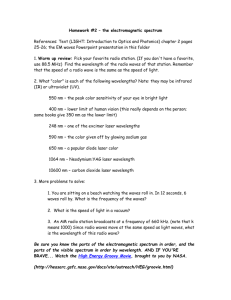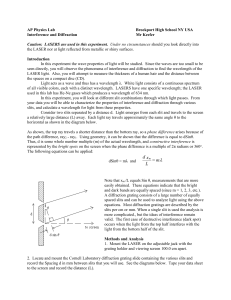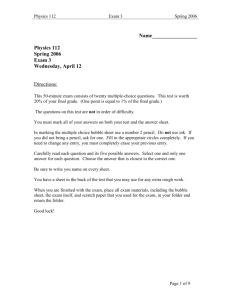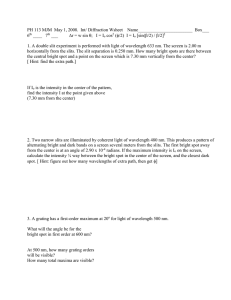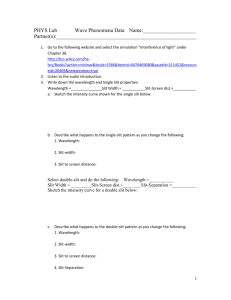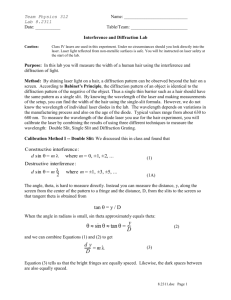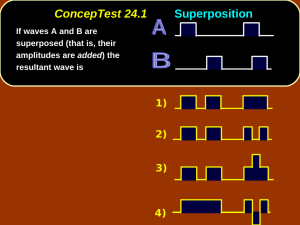Young`s Double Slit Experiment
advertisement
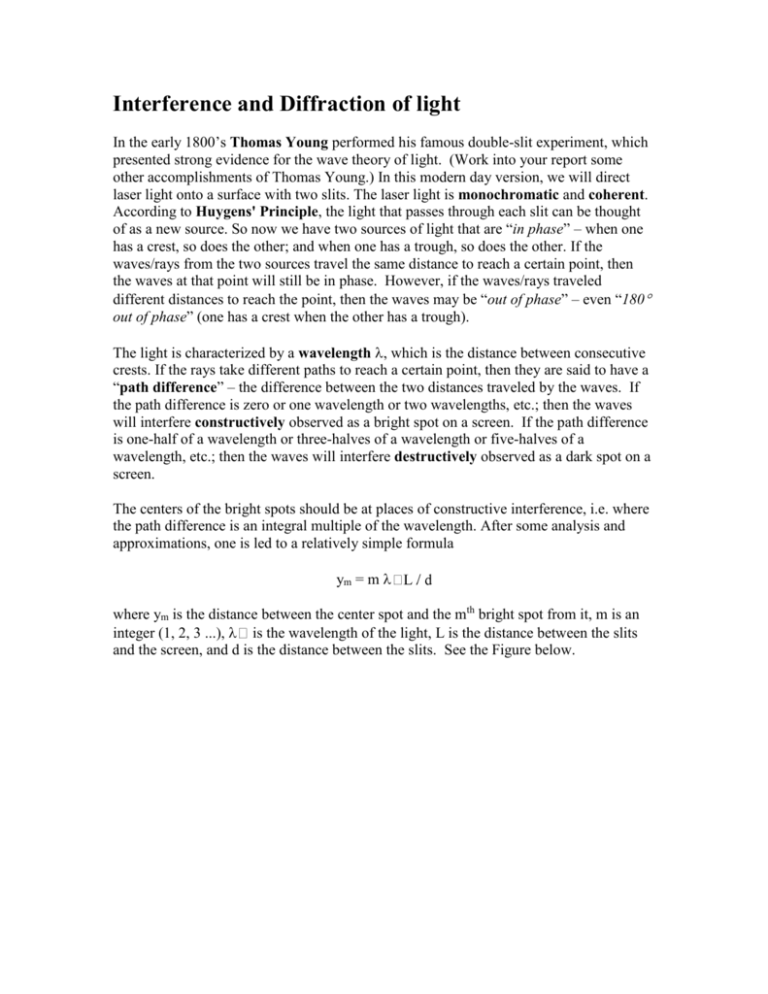
Interference and Diffraction of light In the early 1800’s Thomas Young performed his famous double-slit experiment, which presented strong evidence for the wave theory of light. (Work into your report some other accomplishments of Thomas Young.) In this modern day version, we will direct laser light onto a surface with two slits. The laser light is monochromatic and coherent. According to Huygens' Principle, the light that passes through each slit can be thought of as a new source. So now we have two sources of light that are “in phase” – when one has a crest, so does the other; and when one has a trough, so does the other. If the waves/rays from the two sources travel the same distance to reach a certain point, then the waves at that point will still be in phase. However, if the waves/rays traveled different distances to reach the point, then the waves may be “out of phase” – even “180 out of phase” (one has a crest when the other has a trough). The light is characterized by a wavelength , which is the distance between consecutive crests. If the rays take different paths to reach a certain point, then they are said to have a “path difference” – the difference between the two distances traveled by the waves. If the path difference is zero or one wavelength or two wavelengths, etc.; then the waves will interfere constructively observed as a bright spot on a screen. If the path difference is one-half of a wavelength or three-halves of a wavelength or five-halves of a wavelength, etc.; then the waves will interfere destructively observed as a dark spot on a screen. The centers of the bright spots should be at places of constructive interference, i.e. where the path difference is an integral multiple of the wavelength. After some analysis and approximations, one is led to a relatively simple formula ym = m where ym is the distance between the center spot and the mth bright spot from it, m is an integer (1, 2, 3 ...), is the wavelength of the light, L is the distance between the slits and the screen, and d is the distance between the slits. See the Figure below. Part I. Double Slit: Vary Distance between Slits Attach a multi-slit set (which is comprised of two parts shown below) and a diode laser to an optics bench as shown below. Plug in the laser, turn it on, and adjust the horizontal and vertical settings so that the beam goes through the slit(s) in the center of the multi-slit set and ends on the screen (piece of paper taped to a cabinet or wall across the room). Set the multi-set to the a=0.04 mm, d=0.5 mm double-slit setting (a is slit the thickness, d is the distance between slit centers). Note the wavelength of light (if it's not stamped on the laser, look up the wavelength of red light.) Record the distance L from the multi-slit set to the screen. Observe the interference pattern. Record y – the distance between the middles of the center spot and an adjacent bright spot. Measure the distance between two other adjacent spots (neither of which is the center spot). How does it compare to y? Choose the a=0.04 mm, d=0.25 mm setting and repeat your measurements. Choose the a=0.04 mm, d=0.125 mm setting (the double slit under the multiple slit settings) and repeat measurements. = L= a d y1 (center) y (not center) (mm) (mm) ( ) ( ) 0.040 0.500 0.040 0.250 0.040 0.125 Analysis 1. Plot y versus d and fit it to a power law. Do your results agree with the formula above? Part II. Double Slit: Vary Distance between Set and Screen 1. Set the multi-set back to the a=0.04 mm, d=0.5 mm double-slit setting. 2. Change L, the distance from multi-slit set to screen, record it and re-measure y, the distance between spots. 3. Change L three more times, repeating the measurements. Make sure your L's cover a substantial range. L ( ) y1 (measured) y1 (theory) Percent error ( ) ( ) Analysis 1. Plot y versus L and fit it to a power law. Do your results agree with the formula above? 2. Calculate the theoretical y's from the formula and compare them to your experimental values. Warning: Be careful with units in your calculations.



